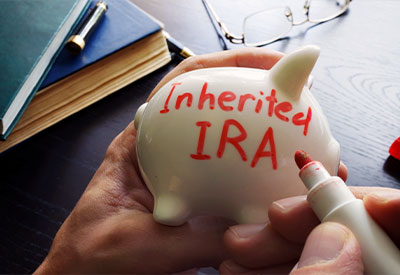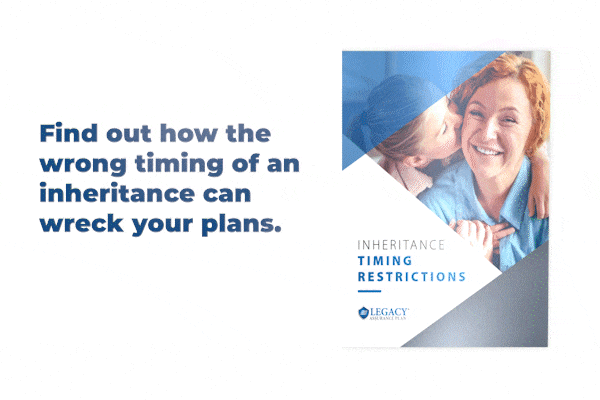Your retirement account isn't just a number on a statement — it’s the culmination of countless sacrifices, careful planning and decades of discipline. Yet for millions of Americans, these hard-earned assets are silently being redirected toward an unintended beneficiary: the Internal Revenue Service (IRS).
The SECURE Act fundamentally altered the landscape of retirement account inheritance, creating one of the most significant tax traps in modern estate planning. What was once a gentle stream of tax obligations spread over a lifetime has transformed into a potential flood of taxation compressed into just 10 years. For your beneficiaries, this means potentially forfeiting 30-40% of your legacy to federal and state tax authorities —precisely at a time when they're dealing with the emotional difficulties of losing you.
This tax acceleration wasn't accidental. Congressional revenue projections for the SECURE Act estimated billions in additional tax collection by forcing accelerated distributions from inherited retirement accounts. Without strategic intervention, your carefully accumulated retirement funds become an unwitting contribution to government coffers rather than the meaningful legacy you intended for your loved ones.
What has changed about IRA inheritance rules?
The SECURE Act of 2019 eliminated what was known as the "stretch IRA" for most beneficiaries. Previously, non-spouse beneficiaries could stretch distributions from an inherited IRA over their lifetime, allowing for decades of tax-deferred growth. Now, most beneficiaries must withdraw the entire balance within 10 years after the original account owner's death.

This accelerated distribution timeline can result in substantial tax consequences, potentially pushing beneficiaries into higher tax brackets and diminishing the overall value of your retirement legacy. With retirement accounts often representing one of the largest assets in many estates, proper planning has become crucial.
Who still qualifies for extended distribution periods?
While the 10-year rule is now standard for most beneficiaries, certain eligible designated beneficiaries can still benefit from more favorable distribution options.
Surviving spouses
Your spouse remains the most advantaged beneficiary for retirement accounts. They have access to several beneficial options:
- The spousal rollover allows them to transfer inherited retirement assets into their own retirement account, continuing tax-deferred growth and following their own required minimum distribution (RMD) schedule.
- Under SECURE 2.0, spousal beneficiaries who choose to maintain the inherited account status receive enhanced life expectancy payout calculations, essentially allowing them to use the Uniform Lifetime Table that retirees use for RMDs. This effectively calculates distributions as if they were 10 years younger than their actual age, extending the distribution period.
Trusts for spouses
If you have concerns about leaving retirement assets directly to your spouse (perhaps due to second marriage considerations, creditor protection needs, or estate tax planning), a properly structured trust can still provide favorable distribution options. A conduit trust for your spouse, where all plan distributions must be passed directly to the spouse during their lifetime, can qualify for the same enhanced life expectancy payout previously mentioned.


Disabled or chronically ill beneficiaries
Beneficiaries who meet the IRS definition of disabled or chronically ill can still receive distributions over their life expectancy. This applies to both outright distributions and properly structured trusts for their benefit.
Beneficiaries not more than 10 years younger
If you're planning to leave retirement assets to someone who is not more than 10 years younger than you (such as a sibling or friend), they can still qualify for life expectancy distributions rather than the 10-year rule.
Minor children of the account owner
Your minor children (not grandchildren or other minors) can use life expectancy distributions until they reach the age of majority, at which point the 10-year rule applies.
What strategies can reduce the tax impact during your lifetime?

Smart planning during your lifetime can significantly reduce the tax burden on your beneficiaries. For many retirees with substantial account balances, counterintuitive approaches may actually yield better after-tax results for heirs than traditional strategies that focus solely on maximizing pre-tax accumulation.
One approach worth considering is actually halting additional retirement contributions once your accounts have grown significantly. Instead, this strategy shifts your focus from tax-deferred accumulation to tax-efficient distribution planning. Rather than continuing to build assets that will face income taxation when withdrawn, you might redirect new savings to non-retirement accounts that will receive a step-up in basis at death. This step-up effectively eliminates capital gains taxes for your heirs, potentially providing more after-tax value than continued retirement account funding.
Another powerful lifetime strategy involves strategically converting traditional IRA assets to Roth IRAs during years when you find yourself in a lower tax bracket. While this conversion requires paying income tax now on the converted amounts, it creates a remarkable benefit: Your beneficiaries will receive completely tax-free distributions later. The mathematics of this approach works particularly well when you anticipate being in a lower current tax bracket than your beneficiaries will face during their inheritance period.
Success also depends on having non-retirement funds available to pay the conversion taxes without depleting the retirement account itself. Additionally, you'll want sufficient time horizon before distributions become necessary, allowing the Roth account value to recover from the initial tax impact and maximize the benefits of tax-free growth.
How important are beneficiary designations in IRA estate planning?

Beneficiary designations are the foundation of effective retirement account estate planning. These designations supersede your will or trust for retirement assets, making them critical documents that should be regularly reviewed and updated. Common mistakes include:
- Outdated designations that don't reflect current wishes.
- Missing contingent beneficiaries.
- Failure to coordinate designations with overall estate plan.
- Neglecting to submit new forms after major life events.
Without proper beneficiary designations, your retirement plan might default to a lump-sum distribution to your estate, triggering immediate taxation and preventing beneficial distribution strategies.
What advanced strategies work for larger families?
Families with multiple children and grandchildren face unique challenges in retirement account planning, but they also enjoy special opportunities that aren't available to smaller families. The diversity of a larger family creates potential for sophisticated income-shifting strategies that can substantially reduce the overall tax burden on inherited retirement assets.
The most notable approach for larger families is what has become known as the "Teapot Trust" strategy, an innovative planning technique developed by Florida attorney Alan Gassman of Clearwater. Understanding this approach requires thinking about your estate not just in terms of equal shares but in terms of tax-efficient distribution pathways. The Teapot Trust strategy works by acknowledging a fundamental reality of our progressive tax system: A dollar distributed to a family member in a lower tax bracket preserves more after-tax value than the same dollar distributed to someone in a higher bracket.
At its core, the Teapot Trust approach involves creating two complementary trusts that work in concert. The first trust serves as the receptacle for retirement plan assets and is responsible for receiving the required distributions from these accounts. Rather than distributing these funds equally among beneficiaries, this trust employs a "spray" provision that gives the trustee discretion to direct distributions strategically toward family members who find themselves in lower tax brackets in any given year. This might mean directing more retirement account distributions to a college student grandchild in a 10% bracket rather than a successful professional child in a 37% bracket.
The second trust in this arrangement holds non-retirement assets and serves as the balancing mechanism. This trust makes distributions to family members who received fewer retirement account distributions, effectively equalizing the total benefits across all family members while minimizing the collective tax burden. Over time, this approach can preserve significantly more family wealth than would be possible with a simple equal division strategy that ignores tax bracket differentials.
Implementing this strategy requires careful drafting by an attorney familiar with both trust law and the nuances of retirement account distribution rules. It also demands ongoing coordination between the trustees and tax advisors to ensure that distributions are optimized annually based on each beneficiary's current tax situation. While more complex than standard approaches, the potential tax savings for larger families can make this sophisticated strategy well worth the additional planning effort.

How can charitable giving enhance your IRA estate plan?
For charitably inclined individuals, retirement assets represent ideal charitable giving vehicles. They include:
Direct charitable beneficiary designations
Naming qualified charities as beneficiaries of retirement accounts is perhaps the most tax-efficient approach. The charity receives the full value of the account without paying income tax, while your estate receives a charitable deduction.
Charitable remainder trusts (CRTs)
A CRT offers perhaps the most powerful tax-advantaged approach for retirement assets. Here's how it works:
- Your retirement account passes to the CRT upon your death, with no immediate income tax due.
- The CRT pays a fixed percentage (at least 5%) of its value each year to your chosen non-charitable beneficiary for their lifetime or a term of years.
- When the income beneficiary passes away or the term ends, the remaining assets go to your chosen charity.
This approach works particularly well for providing income to mature or older beneficiaries while supporting charitable causes you value. The IRS even provides sample CRT forms, demonstrating their acceptance of this planning technique.
Is professional guidance necessary for IRA estate planning?
Given the complexity of retirement account rules and the significant tax implications of improper planning, working with knowledgeable professionals is essential. An estate planning attorney with experience in retirement benefits, possibly in conjunction with financial and tax professionals, can help you comply with these complex rules and implement strategies aligned with your specific goals.
Conclusion
The decisions you make today about your IRA, 401(k) or other retirement accounts will have profound consequences for your loved ones long after you're gone. This isn't merely about financial efficiency — it's about ensuring your life's work brings maximum benefit to the people and causes you value most. You can start by scheduling a comprehensive review of your current beneficiary designations with an experienced estate planning attorney. These seemingly simple forms now carry extraordinary weight in determining the tax treatment of your retirement assets. Even if you've recently updated your will or trust, your retirement accounts might still be directed by outdated beneficiary designations that don't align with current law or your wishes. Remember that retirement account estate planning isn't a one-time event but an ongoing process. As tax laws change, as your family circumstances evolve, and as your retirement accounts grow, regular reviews and adjustments will be necessary to ensure your plan remains optimized.



